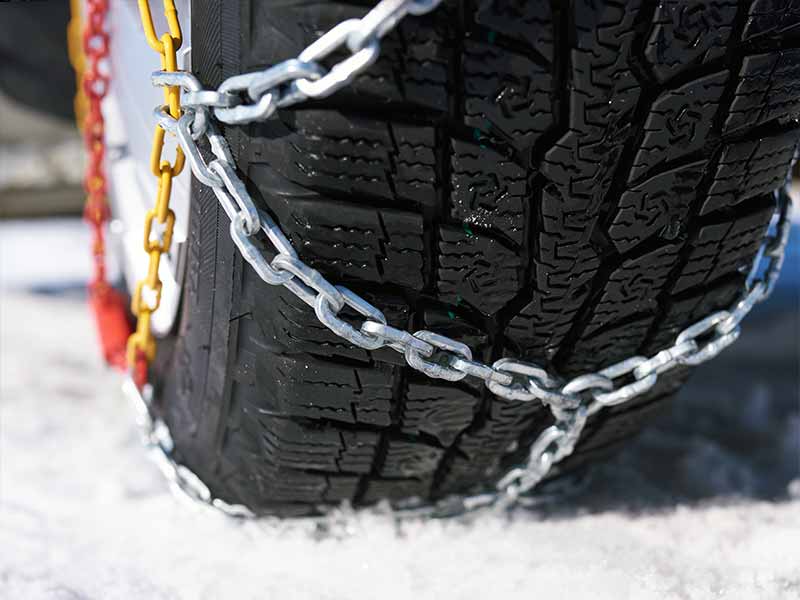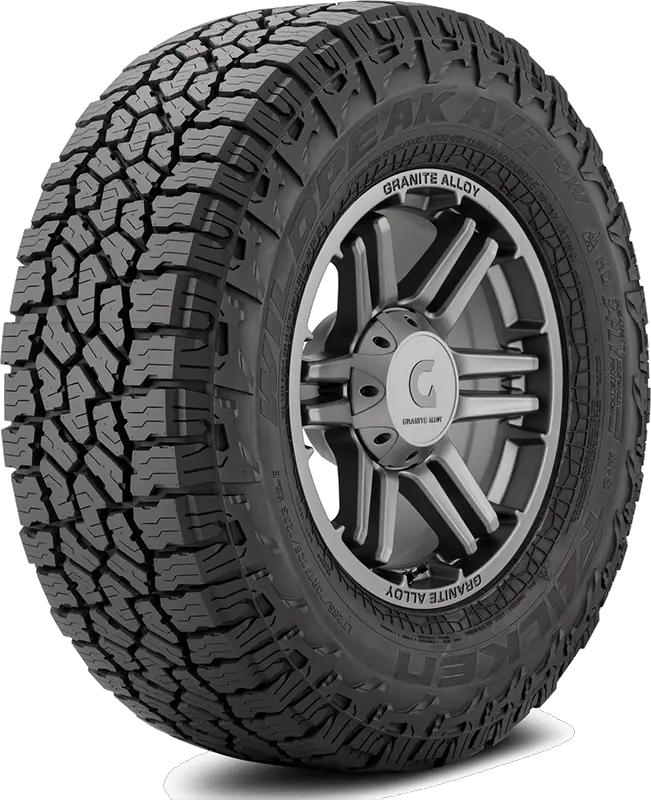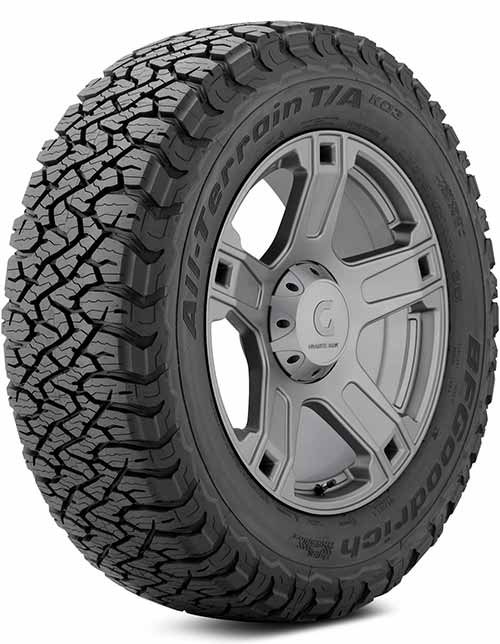Embarking on a wintry road trip and wondering how tire chains tackle traction and wheel spin? Dive into this comprehensive guide, uncovering the secrets of tire chains and snow tires, empowering you with the knowledge needed to conquer icy and snow-covered terrains.
How Do Tire Chains Work?
Tire chains work by the chain links digging into and interlocking with the surface of snow, ice, or mud, creating a firm grip and reducing wheel spin.
This increases traction minimizes slipping and wheel spin, improving stability and control in challenging weather conditions.
In this article, we’ll unravel the mechanics behind tire chains and snow tires, examining their functionality and when to use them.
From choosing the right chains to understanding their installation process and driving considerations, we’ll cover it all. We’ll also compare snow chains and snow tires, helping you determine the most suitable solution for safe winter driving.
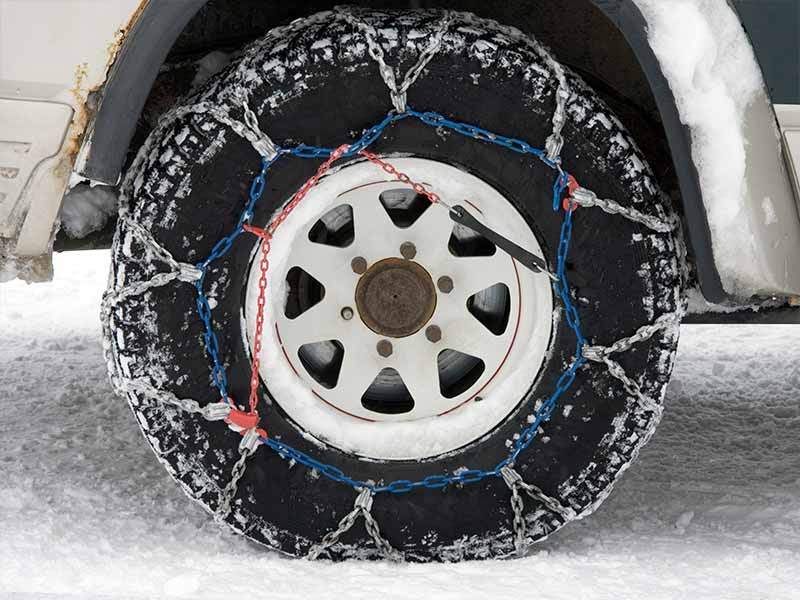
What are Tire Chains?
Tire chains are robust, linked chains that wrap around your tires to enhance traction on snow, ice, or muddy terrains. These chains essentially provide your tires with a more profound grip, minimizing wheel spin and improving stability in treacherous conditions.
How Do Tire Chains Work?
Allow me to break it down: when roads are covered in snow or ice, regular tires might struggle for grip. Here’s where tire chains come into play:
- Enhanced Traction: The chain links dig into the snow or ice, creating a firmer connection between the tire and the road surface.
- Reduced Slipping: By preventing excessive wheel spin, tire chains help your vehicle maintain traction, allowing you to move forward more effectively.
- Improved Handling: These chains also enhance your ability to steer and brake, providing a better sense of control.
Tire chains are a game-changer in snowy or icy conditions, giving you the confidence to navigate roads that might otherwise be impassable.
Types of Tire Chains
There are different types of tire chains available, each suited for specific conditions:
- Traditional Tire Chains: These heavy-duty chains are optimal for deep snow conditions, offering superior traction.
- Cable Chains: With lighter and more flexible cables, these chains are ideal for less extreme snow and provide a smoother ride.
Understanding these distinctions can help you choose the right chains based on the severity of the weather and your driving needs.
If you’re interested in knowing more about snow tires versus tire chains, check out our article Snow Tires vs. Chains for comprehensive insights.
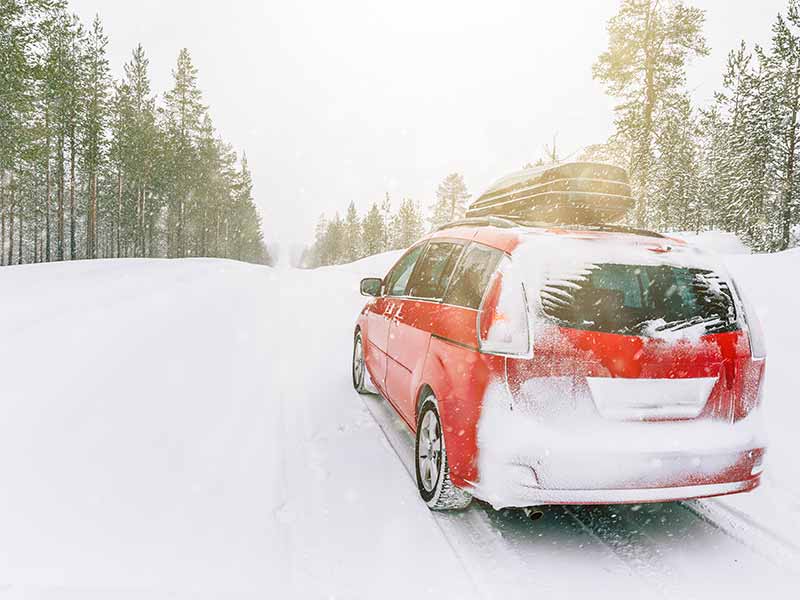
When Should You Put On Tire Chains?
I understand the significance of timing when it comes to installing tire chains. Let’s delve into the crucial scenarios that warrant the use of tire chains for your vehicle’s safety and optimal performance.
Understanding the Conditions
The decision to put on tire chains hinges on various factors, primarily dictated by the prevailing weather and road conditions:
- Heavy Snowfall and Deep Snow Conditions: When the snow starts piling up, and the roads are blanketed with deep snow, tire chains become essential. They provide the necessary traction to keep you moving forward without slipping or getting stuck.
- Icy or Slushy Roads: Tire chains are your best bet when roads are covered in ice or slush. They enhance grip and stability, reducing the risk of skidding or sliding.
- Severe Winter Weather Warnings: Pay heed to weather forecasts indicating severe winter conditions. If snowstorms are expected or if icy roads are anticipated, consider installing tire chains preemptively for safer travels.
- Uphill Climbs or Declines in Snowy Terrain: When navigating steep inclines or declines in snowy areas, tire chains are indispensable. They offer the traction needed to ascend or descend without losing control.
- Legal Requirements or Road Signs Mandating Chains: Certain regions have legal requirements or specific road signs that mandate the use of tire chains in adverse weather conditions. Adhering to these regulations isn’t just about compliance but also about ensuring your safety on the road.
Preparation and Readiness
It’s crucial to have your tire chains ready before you encounter challenging conditions. Familiarize yourself with the installation process and ensure your chains fit your tires properly. Practice installing them in a controlled environment to be ready when the need arises.
For further insights into when to use tire chains with specific drivetrains like all-wheel drive (AWD), check out Do You Need Snow Tires with AWD? to make informed decisions based on your vehicle’s capabilities.
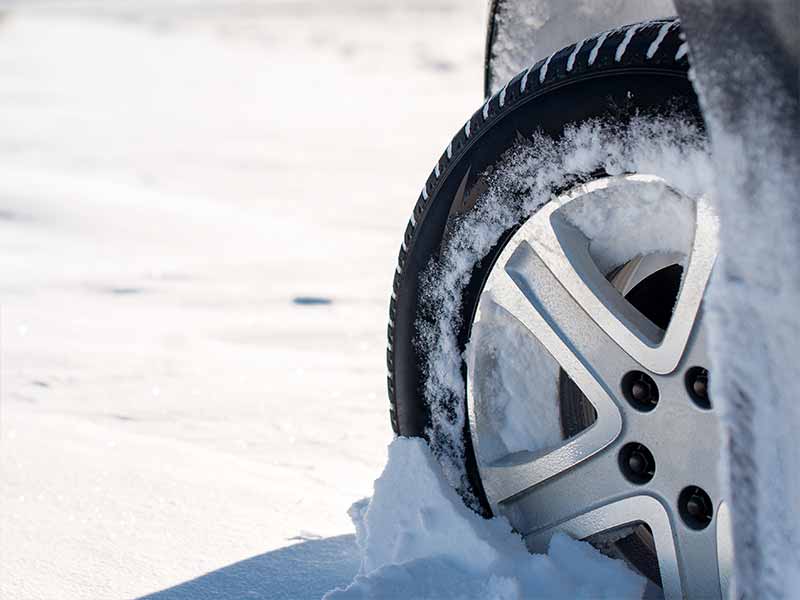
Which Tires Require Tire Chains?
Understanding which tires necessitate tire chains is crucial for safe and effective driving:
- Snow Tires vs. Regular Tires: While snow tires offer enhanced traction in winter conditions, they might still require tire chains in extreme circumstances, especially when driving through deep snow or on icy surfaces.
- Front-Wheel Drive vs. Rear-Wheel Drive: Vehicles with rear-wheel drive often benefit more from tire chains due to the weight distribution, but front-wheel drive vehicles may also need tire chains for added traction in challenging conditions.
- All-Wheel Drive (AWD) and Four-Wheel Drive (4WD) Vehicles: Even though AWD and 4WD vehicles provide better traction, tire chains may still be necessary in severe snow or ice to further improve grip.
Do You Need Snow Chains on All Four Tires?
While some situations may require tire chains on all four tires for optimal performance and safety, such as severe snowstorms or icy roads, there are instances where chains on just the drive wheels might suffice. It’s crucial to assess the conditions and your vehicle’s drivetrain to determine the most effective placement of tire chains.
Factors for Selection
When choosing tire chains, consider the following factors:
- Restricted Wheel Well Clearance: Some vehicles, particularly those with limited wheel well space, might require low-profile or specialized tire chains to ensure a proper fit without causing damage.
- Tire Chains vs. Cables: While tire chains offer robust traction in severe conditions, cable-style chains are lighter and more flexible, providing smoother rides in less extreme snow.
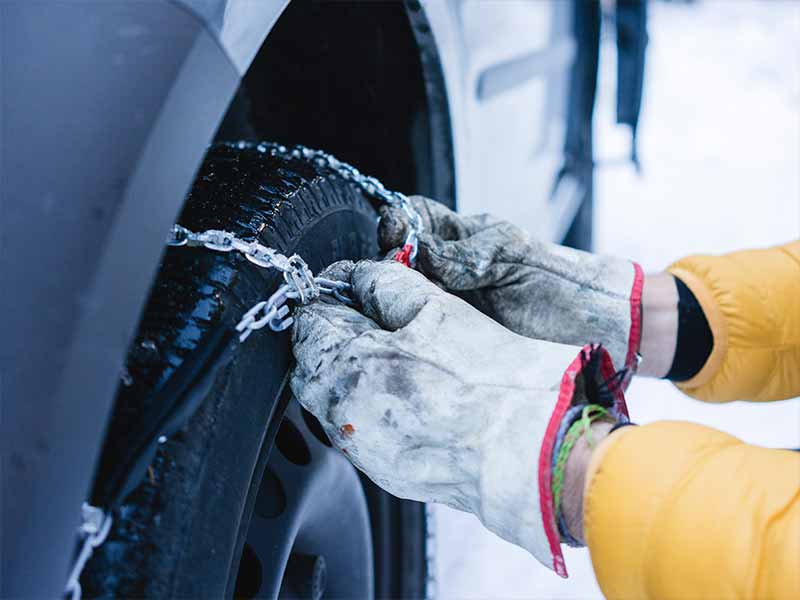
Installing and Driving with Tire Chains
Let’s delve into the essential steps of installing tire chains and driving with them for a secure and controlled ride.
How to Install Tire Chains
Installing tire chains can be straightforward if you’re familiar with the process. Here’s a step-by-step guide:
- Preparation: Lay out the chains on the ground and untangle them if needed. Ensure the chains are the correct size for your tires.
- Placement: Position the chains over the tire, making sure they’re centered and evenly distributed.
- Securing: Connect the ends of the chains and fasten them securely. Make any necessary adjustments to ensure a snug fit.
- Test Drive: Drive a short distance and check if the chains require further tightening or adjustments.
Driving with Tire Chains
Once the tire chains are properly installed, driving with them requires some precautions:
- Reduced Speed: Drive at moderate speeds, usually around 30 mph or below, to maintain control and prevent damage to both the chains and the road surface.
- Smooth Acceleration and Braking: Apply gas and brake pedals gently to avoid sudden movements that might lead to skidding.
- Avoid Hard Turns: Maneuver your vehicle gently, avoiding sharp turns or abrupt movements that could dislodge the chains.
- Regular Inspections: Periodically check the chains during your drive to ensure they remain secure and properly fitted.
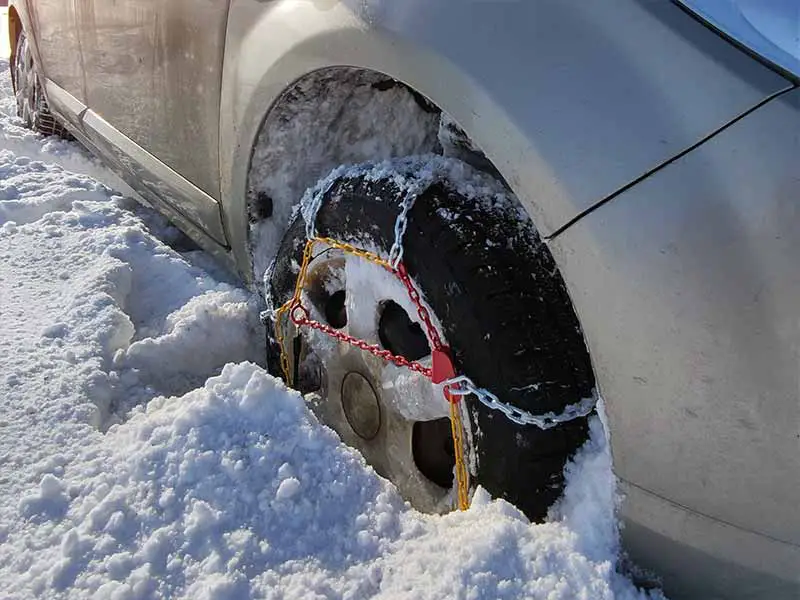
Snow Chains vs. Snow Tires: Which is Right for You?
Understanding the distinctions between winter tires and snow tire chains is important in determining the most suitable solution for your driving needs, be it for navigating deep snow or ensuring better traction on icy surfaces.
Let’s explore the differences between these two solutions to assist you in making the best choice suited to your driving needs.
Understanding Snow Tires
Snow Tires: Also known as winter or studded tires, these specialized tires are designed with deeper treads and unique rubber compounds, specifically crafted to perform better in cold weather conditions.
- Enhanced Traction: Snow tires feature deeper grooves and specialized tread patterns, offering superior grip on snow, ice, or wet surfaces.
- Studded Tires: Some snow tires have metal studs embedded in the tread, providing additional traction in extremely icy conditions, although they might be prohibited on some roads due to potential damage to pavement.
Snow Chains vs. Snow Tires Comparison
Snow Chains vs. Snow Tires: Both snow chains and snow tires aim to improve traction in adverse conditions, but they differ in various aspects.
- Traction and Performance: Snow tires excel in providing consistent traction on winter roads, while snow chains are ideal for extreme situations, offering unparalleled grip in deep snow or on extremely icy surfaces.
- Application in Deep Snow: Snow tires generally perform well in moderate winter conditions, but for traversing deep snow, especially in remote or rugged terrains, snow chains might offer superior traction.
Resources
Below are some links you may find helpful when learning about tires:
- An introduction to tire chains for snow – The Drive
- How to put snow chains on your tires – Family Handyman
Final Thoughts
Mastering the workings of tire chains is key to navigating wintry roads with confidence. Whether it’s the exceptional traction offered by tire chains in extreme snow or the consistent performance of snow tires in winter conditions, understanding their roles empowers you to make informed choices for safer winter travels.
Good luck and happy motoring.
